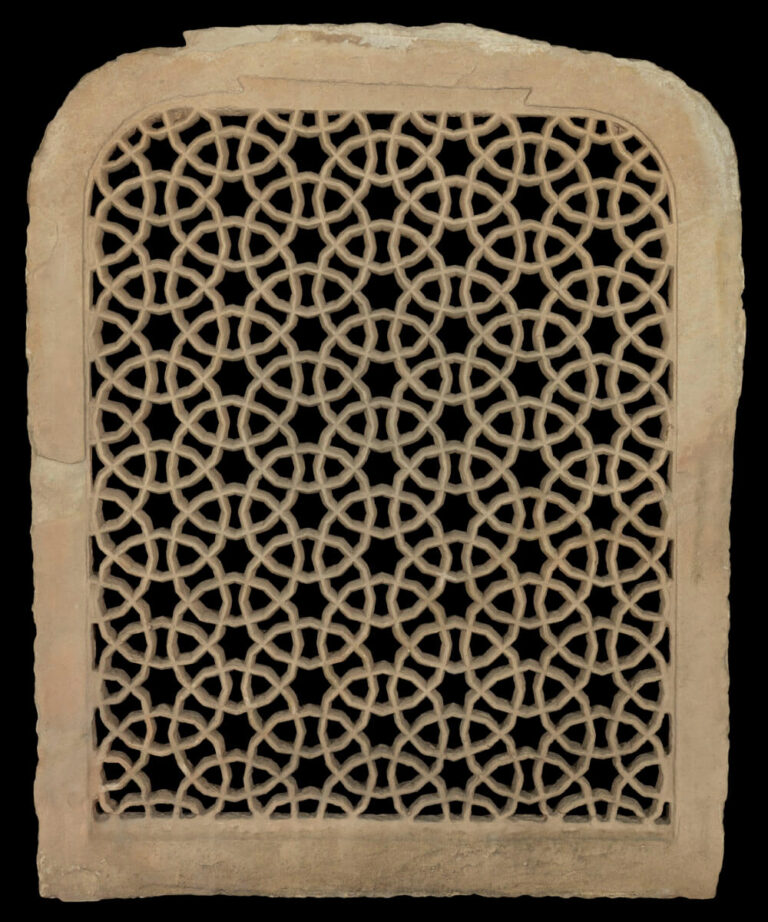Inv. no. LNS 105 S
Carved by mason’s means
Height 120 cm; width 100 cm
Northern India, late 16th – early 17th century AD
late 10th – early 11th century AH
Stone & Stucco
Stone and stucco have a long history in the art and cultures that became the Islamic world. Even as far back as the Bronze Age, stone was used to create almost reverential objects of sacred animals, demons and gods/goddesses.
Stone and stucco remained the chosen media for an important and characteristic Islamic architectural element: carved and pierced window screening panels which allowed ventilation while providing privacy and shade to the interior. From early Islamic times these were executed in both materials and were employed in religious and secular buildings. Stucco techniques were highly developed and widely used to embellish interiors as well as these window grilles.
Islamic masons inherited a tradition of carving stone for decorating the exteriors and interiors of buildings from the ancient world, and the palaces of the first Islamic dynasty, the Umayyad Caliphs, were enhanced by richly carved vegetal and abstract motifs. Arabic calligraphy soon became one of the most important elements of architectural decoration. Beautiful examples of calligraphy on tombstones provide us with important fixed chronologies for the development of a variety of calligraphic styles.
In the Mughal era stone predominated, and many large and beautiful screens were produced. White marble panels inlaid with semi-precious stones and other coloured materials were also created during in India during that period.

LNS 105 S
Pierced sandstone screen (jali) featuring a pattern of six-pointed stars...

LNS 285 S
Marble fountain basin with Indian-style rosettes in the corners and...

LNS 285 S
Marble fountain basin with Indian-style rosettes in the corners and featuring at the centre a hemispherical boss carved with a ‘pattern’ comprised of an eight-pointed star and eight small five-pointed stars
Inv. no. LNS 285 S
Carved by mason’s means
Height 21 cm; width 65 x 65 cm
East Iranian world, probably Ghazni, 12th – early 13th century AD
6th – early 7th century AH
You can share this object via:

LNS 32 ST c
Two stucco ten-pointed star tiles, one with a representation of...

LNS 32 ST c
Two stucco ten-pointed star tiles, one with a representation of a leogryph, the other with an elephant carrying a rabbit with its trunk, both on a ground of half-palmette arabesques (from a series of four in the collection)
Inv. no. LNS 32 ST a, c
Moulded and carved
Average height 49 cm; average width 50.5 cm
Western Iran (possibly Rayy), 12th century AD
6th century AH
You can share this object via:

LNS 32 ST a
Two stucco ten-pointed star tiles, one with a representation of...

LNS 32 ST a
Two stucco ten-pointed star tiles, one with a representation of a leogryph, the other with an elephant carrying a rabbit with its trunk, both on a ground of half-palmette arabesques (from a series of four in the collection)
Inv. no. LNS 32 ST a, c
Moulded and carved
Average height 49 cm; average width 50.5 cm
Western Iran (possibly Rayy), 12th century AD
6th century AH
You can share this object via:
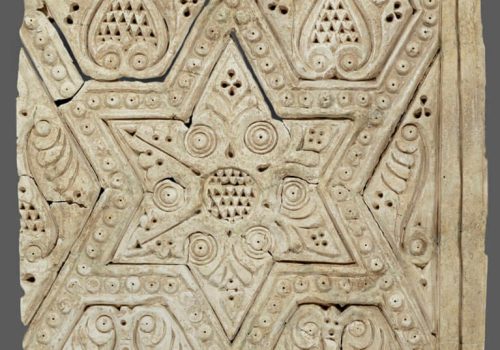
LNS 13 S
Stucco architectural panel (from a dado), with a section from...

LNS 13 S
Stucco architectural panel (from a dado), with a section from the infinite pattern of regular six-pointed stars and hexagons (equilateral triangle plan of repetition), with subtly and beautifully carved foliate and floral motifs inside the compartments
Inv. no. LNS 13 ST
Carved in the rigid but soft state with chisels and custom-purpose drills
Height 93 cm; width 63.5 cm
East Iranian world, probably Nishapur, ca. late 9th – 10th century AD
ca. late 3rd – 4th century AH
You can share this object via:

LNS 4 S
Marble tombstone with Kufic inscription giving the name and patronymics...

LNS 4 S
Marble tombstone with Kufic inscription giving the name and patronymics of the lady Umm al-Futuh bint al-Qa’id Lu’lu’, and the month of Sha‘ban 547 AH/November - December 1152 AD as the date of her death. The last line states that it is the tombstone of Amir Muhanna and his wife.
Inv. no. LNS 4 S
Carved by mason’s means
Height 52.5 cm; width 39 cm
Egypt, dated in the month of Sha‘ban 547 AH/November-December 1152 AD
You can share this object via:

LNS 27 S
Marble architectural panel featuring a fragmentary elaborate and mannered ‘archaizing’...

LNS 27 S
Marble architectural panel featuring a fragmentary elaborate and mannered ‘archaizing’ Kufic inscription with ‘the great, the noble’, perhaps part of the foundation inscription of a religious school or a tomb
Inv. no. LNS 27 S
Carved by mason’s means
Height 45 cm; width 39.3 cm
East Iranian world, Ghazni, late 11th – early 12th century AD
late 5th – early 6th century AH
You can share this object via:

LNS 231 S
Sandstone architectural crenellation element of foliate form, relief-carved with a...

LNS 231 S
Sandstone architectural crenellation element of foliate form, relief-carved with a bilaterally symmetrical foliate composition issuing from a half-rosette, and two roundels with the word ‘Allah’ (God)
Inv. no. LNS 231 S
Carved by mason’s means
Height 100.8 cm; width 65.8 cm
North India, late 16th century AD
late 10th century AH
You can share this object via:

LNS 183 S
Schist cenotaph of Prince Shams al-Milla wa 'd-Din Muhammad, son...

LNS 183 S
Schist cenotaph of Prince Shams al-Milla wa 'd-Din Muhammad, son of Nizam ad-Din Wali Beg, with inscriptions in thuluth (Persian and Arabic) and Kufic (Arabic) scripts, and with squinches, interlaces and floral decoration
Inv. no. LNS 183 S
Carved by mason’s means
Height 27.5 cm; length 117 cm
East Iranian world or Central Asia, dated 930 AH/1523-24 AD
You can share this object via:

LNS 129 S
Limestone tombstone in the form of an architectural niche with...

LNS 129 S
Limestone tombstone in the form of an architectural niche with muqarnas squinches and inscriptions in naskhi script (the inner rectangular frame with Chapter 112 of the Qur’an, and the lower part identifying the tomb as that of Shaykh Zad Muhammad bn Muhammad and giving the date of his death). The upper part of the inner niche filled with an infinite-repetition geometric star pattern (triangle plan of repetition, six-pointed stars and other polygons)
Inv. no. LNS 129 S
Carved by mason’s means
Height 40.5 cm; width 33 cm
Iranian world, dated Rabi‘ al-Awwal 704 AH/October-November 1304 AD
You can share this object via:

LNS 3 HS
Rock crystal bottle, relief-carved on both faces with a stylised...
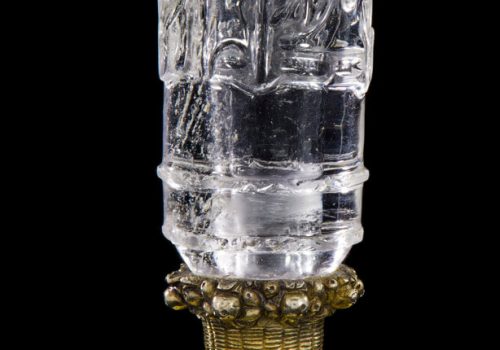
LNS 43 HS
Rock crystal bottle, relief-carved with good wishes to the owner...

LNS 43 HS
Rock crystal bottle, relief-carved with good wishes to the owner in Kufic script. The bottle probably served as a reliquary and was fitted in the 16th-century with Spanish gilded silver mounts inscribed: ‘In hoc signo vinces’, and engraved with the coats of arms of Barba de Campos de Castrofuerte of Castille, Santillan of Castille, Tello Barba Sandoval Santillan, and Tello of Castille
Inv. no. LNS 43 HS
Cut, ground and polished by lapidary means; silver mounts cast, fabricated, engraved and gilded
Height 17.8 cm; diameter 4.4 cm
Bottle east Iranian world, ca. 10th century AD
ca. 4th century AH
You can share this object via:
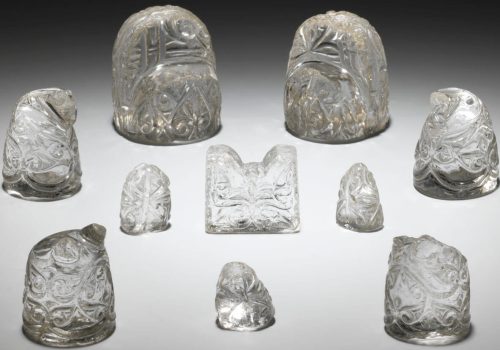
LNS 1 HS a, d, e, g, h, i
Rock crystal chess pieces from two different sets, relief-carved with...
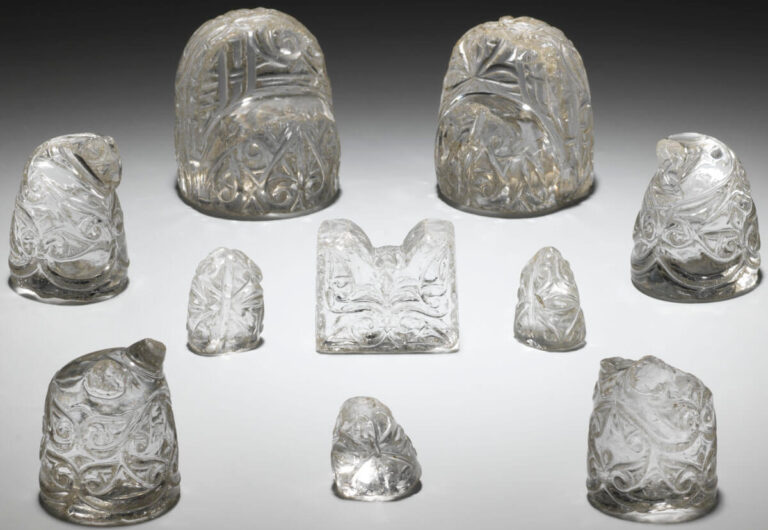
LNS 1 HS a, d, e, g, h, i
Rock crystal chess pieces from two different sets, relief-carved with palmettes and half-palmettes (a, h, and i from one set; and d, e, and g from another), the pieces consist of:
(a) Shah (the king), the ultimate origin of the shape is thought to be a royal howdah on the back of an elephant
Inv. no. LNS 1 HS a, d, e, g, h, i
Cut, ground and polished by lapidary means
(a) Height 6.8 cm; diameter 6 cm;
LNS 1 HS a, h, and i, East Iranian world, ca. 9th century AD;
ca. 6th century AH
You can share this object via:

LNS 1 S
Marble capital carved in a form derived from the Corinthian...

LNS 1 S
Marble capital carved in a form derived from the Corinthian order, with an inscription in Kufic script giving the name of the stone carver (Shukr the young slave or fata), its date of manufacture, and invoking blessings on the patron, the Spanish Umayyad Caliph ‘Abd Allah al-Hakam al-Mustansir bi-’llah (r. 350 – 366 AH/961-976 AD)
Inv. no. LNS 1 S
Carved by mason’s means
Height 38.5 cm; width 26 cm
Spain, probably Cordoba or Madinat az-Zahra, dated 364 AH/974-5 AD
You can share this object via:

LNS 160 S
Basalt tombstone of a certain Rizq ibn ‘Abdallah...

LNS 65 S e
Limestone niche from the Audience Hall of the Citadel Complex...

LNS 65 S e
Limestone niche from the Audience Hall of the Citadel Complex of Amman, probably built during the reign of the Umayyad Caliph Hisham bn Abd al-Malik, between 724 and 743 AD
Inv. no. LNS 65 S e
Carved by mason’s means
Height 93 cm; width 63 cm
Jordan, 1st half 8th century AD
1st half 2nd century AH
You can share this object via:
